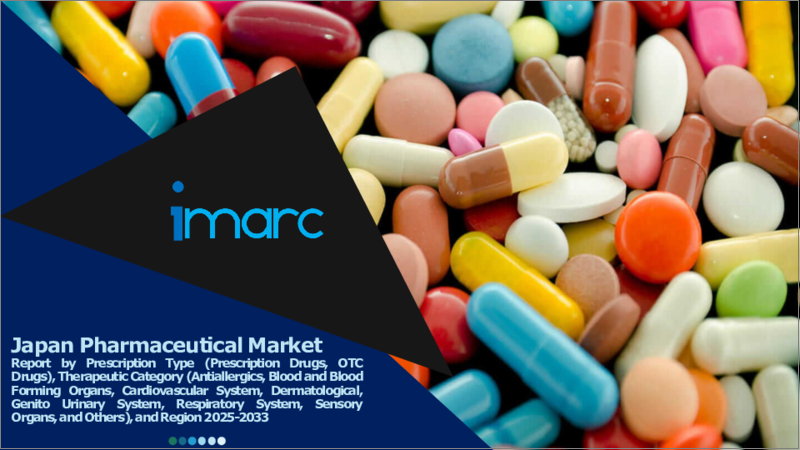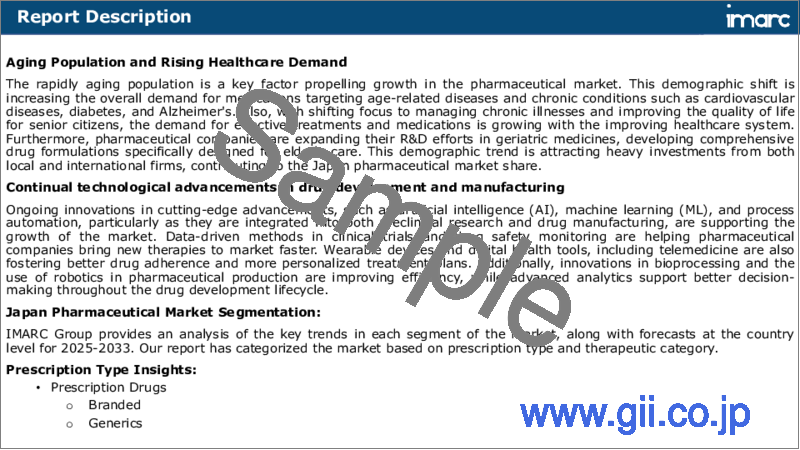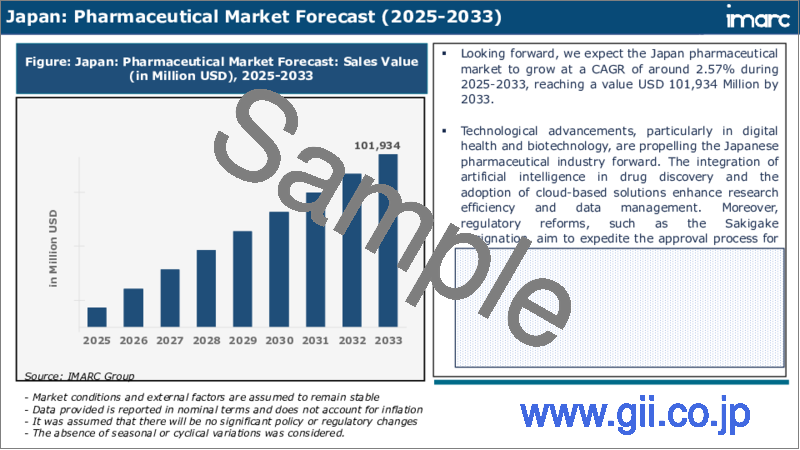|
|
市場調査レポート
商品コード
1729413
日本の医薬品市場レポート:処方タイプ、治療カテゴリー、地域別、2025年~2033年Japan Pharmaceutical Market Report by Prescription Type, Therapeutic Category, and Region 2025-2033 |
||||||
カスタマイズ可能
|
|||||||
| 日本の医薬品市場レポート:処方タイプ、治療カテゴリー、地域別、2025年~2033年 |
|
出版日: 2025年05月01日
発行: IMARC
ページ情報: 英文 119 Pages
納期: 5~7営業日
|
全表示
- 概要
- 目次
日本の医薬品市場規模は2024年に822億7,000万米ドルに達しました。IMARC Groupは、2025年から2033年にかけての成長率(CAGR)は2.57%で、2033年には1,019億米ドルに達すると予測しています。数多くの治療法や革新的な治療法、医薬品開発のための研究開発活動への投資の増加が、主に市場の成長を促進しています。
本レポートで扱う主な質問
- 日本の医薬品市場はこれまでどのように推移し、今後どのように推移するのか?
- COVID-19が日本の医薬品市場に与えた影響は?
- 日本の医薬品市場の処方タイプ別区分は?
- 日本の医薬品市場の治療カテゴリー別の区分は?
- 日本の医薬品市場のバリューチェーンにおける様々なステージとは?
- 日本の医薬品の主な促進要因と課題は何か?
- 日本の医薬品市場の構造と主要プレーヤーは?
- 日本の医薬品市場における競合の程度は?
目次
第1章 序文
第2章 調査範囲と調査手法
- 調査の目的
- ステークホルダー
- データソース
- 市場推定
- 調査手法
第3章 エグゼクティブサマリー
第4章 日本の医薬品市場:イントロダクション
- 概要
- 市場力学
- 業界動向
- 競合情報
第5章 日本の医薬品市場情勢
- 過去および現在の市場動向(2019~2024年)
- 市場予測(2025~2033年)
第6章 日本の医薬品市場:処方タイプ別内訳
- 処方薬
- OTC薬
第7章 日本の医薬品市場:治療カテゴリー別内訳
- 抗アレルギー薬
- 血液と造血器官
- 心臓血管系
- 皮膚科
- 泌尿器生殖器系
- 呼吸器系
- 感覚器官
- その他
第8章 日本の医薬品市場:競合情勢
- 概要
- 市場構造
- 市場企業のポジショニング
- 主要成功戦略
- 競合ダッシュボード
- 企業評価象限
第9章 主要企業のプロファイル
第10章 日本の医薬品市場:業界分析
- 促進要因、抑制要因、機会
- ポーターのファイブフォース分析
- バリューチェーン分析
第11章 付録
Japan pharmaceutical market size reached USD 82.27 Billion in 2024. Looking forward, IMARC Group expects the market to reach USD 101.90 Billion by 2033, exhibiting a growth rate (CAGR) of 2.57% during 2025-2033. Numerous treatments and innovative therapies and the increasing investments in the R&D activities for developing medicines, are primarily augmenting the market growth.
The pharmaceutical industry represents a confluence of science, innovation, and therapeutic care, dedicated to advancing global health. At its core, this sector is responsible for the research, development, production, and distribution of medications designed to prevent, manage, or cure a plethora of medical conditions and diseases. Spanning from life-saving vaccines to everyday pain relievers, pharmaceuticals play an integral role in enhancing the quality of life and increasing life expectancy. The journey of drug development is a complex and rigorous process, necessitating extensive research, clinical trials, and regulatory approvals to ensure both efficacy and safety for patients. Beyond the tangible medications, the pharmaceutical industry's value also lies in its relentless pursuit of new therapeutic frontiers, breakthrough treatments, and innovations that have the potential to redefine medical paradigms. As health challenges continue to evolve, the importance of this industry, underpinned by its commitment to bettering human health, remains paramount.
Japan Pharmaceutical Market Trends:
Growing investments in biopharmaceuticals and precision medicine
Growing investments in biopharmaceuticals and precision medicines is rapidly transforming the dynamics of the pharmaceutical industry in Japan. Biopharmaceuticals, such as biologics, and biosimilars are gaining more preference due to originality in treatment of chronic diseases, such as cancer or autoimmune diseases. With advancements in genomics and personalized medicine, the focus is shifting towards treatments tailored to individual genetic profiles. As a result, major Japanese drug manufacturers are engaging in joint ventures involving overseas companies and research centers to foster this technology. An enhanced focus on individualized treatments is further extending the range of the pharmaceutical market by offering targeted solutions to previously hard-to-solve diseases.
Aging Population and Rising Healthcare Demand
The rapidly aging population is a key factor propelling growth in the pharmaceutical market. This demographic shift is increasing the overall demand for medications targeting age-related diseases and chronic conditions such as cardiovascular diseases, diabetes, and Alzheimer's. Also, with shifting focus to managing chronic illnesses and improving the quality of life for senior citizens, the demand for effective treatments and medications is growing with the improving healthcare system. Furthermore, pharmaceutical companies are expanding their R&D efforts in geriatric medicines, developing comprehensive drug formulations specifically designed for elderly care. This demographic trend is attracting heavy investments from both local and international firms, contributing to the Japan pharmaceutical market share.
Continual technological advancements in drug development and manufacturing
Ongoing innovations in cutting-edge advancements, such as artificial intelligence (AI), machine learning (ML), and process automation, particularly as they are integrated into both preclinical research and drug manufacturing, are supporting the growth of the market. Data-driven methods in clinical trials and drug safety monitoring are helping pharmaceutical companies bring new therapies to market faster. Wearable devices and digital health tools, including telemedicine are also fostering better drug adherence and more personalized treatment plans. Additionally, innovations in bioprocessing and the use of robotics in pharmaceutical production are improving efficiency, while advanced analytics support better decision-making throughout the drug development lifecycle.
Japan Pharmaceutical Market Segmentation:
Prescription Type Insights:
- Prescription Drugs
- Branded
- Generics
- OTC Drugs
Therapeutic Category Insights:
- Antiallergics
- Blood and Blood Forming Organs
- Cardiovascular System
- Dermatological
- Genito Urinary System
- Respiratory System
- Sensory Organs
- Others
Competitive Landscape:
The market research report has also provided a comprehensive analysis of the competitive landscape. Competitive analysis such as market structure, key player positioning, top winning strategies, competitive dashboard, and company evaluation quadrant has been covered in the report. Also, detailed profiles of all major companies have been provided.
Japan Pharmaceutical Market News:
- On 1st October 2024, Nxera Pharma Co., Ltd. formed a partnership agreement with Shionogi & Co., Ltd. regarding the distribution and sales for QUVIVIQ(TM) (daridorexant 25 and 50 mg) in Japan. QUVIVIQ is a novel dual orexin receptor antagonist, discovered by Idorsia Pharmaceuticals Ltd, that was approved by the ministry of health, labour, and welfare of Japan ("MHLW") for the treatment of adult patients with insomnia.
Key Questions Answered in This Report:
- How has the Japan pharmaceutical market performed so far and how will it perform in the coming years?
- What has been the impact of COVID-19 on the Japan pharmaceutical market?
- What is the breakup of the Japan pharmaceutical market on the basis of prescription type?
- What is the breakup of the Japan pharmaceutical market on the basis of therapeutic category?
- What are the various stages in the value chain of the Japan pharmaceutical market?
- What are the key driving factors and challenges in the Japan pharmaceutical?
- What is the structure of the Japan pharmaceutical market and who are the key players?
- What is the degree of competition in the Japan pharmaceutical market?
Table of Contents
1 Preface
2 Scope and Methodology
- 2.1 Objectives of the Study
- 2.2 Stakeholders
- 2.3 Data Sources
- 2.3.1 Primary Sources
- 2.3.2 Secondary Sources
- 2.4 Market Estimation
- 2.4.1 Bottom-Up Approach
- 2.4.2 Top-Down Approach
- 2.5 Forecasting Methodology
3 Executive Summary
4 Japan Pharmaceutical Market - Introduction
- 4.1 Overview
- 4.2 Market Dynamics
- 4.3 Industry Trends
- 4.4 Competitive Intelligence
5 Japan Pharmaceutical Market Landscape
- 5.1 Historical and Current Market Trends (2019-2024)
- 5.2 Market Forecast (2025-2033)
6 Japan Pharmaceutical Market - Breakup by Prescription Type
- 6.1 Prescription Drugs
- 6.1.1 Overview
- 6.1.2 Historical and Current Market Trends (2019-2024)
- 6.1.3 Market Segmentation
- 6.1.3.1 Branded
- 6.1.3.2 Generics
- 6.1.4 Market Forecast (2025-2033)
- 6.2 OTC Drugs
- 6.2.1 Overview
- 6.2.2 Historical and Current Market Trends (2019-2024)
- 6.2.3 Market Forecast (2025-2033)
7 Japan Pharmaceutical Market - Breakup by Therapeutic Category
- 7.1 Antiallergics
- 7.1.1 Overview
- 7.1.2 Historical and Current Market Trends (2019-2024)
- 7.1.3 Market Forecast (2025-2033)
- 7.2 Blood and Blood Forming Organs
- 7.2.1 Overview
- 7.2.2 Historical and Current Market Trends (2019-2024)
- 7.2.3 Market Forecast (2025-2033)
- 7.3 Cardiovascular System
- 7.3.1 Overview
- 7.3.2 Historical and Current Market Trends (2019-2024)
- 7.3.3 Market Forecast (2025-2033)
- 7.4 Dermatological
- 7.4.1 Overview
- 7.4.2 Historical and Current Market Trends (2019-2024)
- 7.4.3 Market Forecast (2025-2033)
- 7.5 Genito Urinary System
- 7.5.1 Overview
- 7.5.2 Historical and Current Market Trends (2019-2024)
- 7.5.3 Market Forecast (2025-2033)
- 7.6 Respiratory System
- 7.6.1 Overview
- 7.6.2 Historical and Current Market Trends (2019-2024)
- 7.6.3 Market Forecast (2025-2033)
- 7.7 Sensory Organs
- 7.7.1 Overview
- 7.7.2 Historical and Current Market Trends (2019-2024)
- 7.7.3 Market Forecast (2025-2033)
- 7.8 Others
- 7.8.1 Historical and Current Market Trends (2019-2024)
- 7.8.2 Market Forecast (2025-2033)
8 Japan Pharmaceutical Market - Competitive Landscape
- 8.1 Overview
- 8.2 Market Structure
- 8.3 Market Player Positioning
- 8.4 Top Winning Strategies
- 8.5 Competitive Dashboard
- 8.6 Company Evaluation Quadrant
9 Profiles of Key Players
- 9.1 Company A
- 9.1.1 Business Overview
- 9.1.2 Product Portfolio
- 9.1.3 Business Strategies
- 9.1.4 SWOT Analysis
- 9.1.5 Major News and Events
- 9.2 Company B
- 9.2.1 Business Overview
- 9.2.2 Product Portfolio
- 9.2.3 Business Strategies
- 9.2.4 SWOT Analysis
- 9.2.5 Major News and Events
- 9.3 Company C
- 9.3.1 Business Overview
- 9.3.2 Product Portfolio
- 9.3.3 Business Strategies
- 9.3.4 SWOT Analysis
- 9.3.5 Major News and Events
- 9.4 Company D
- 9.4.1 Business Overview
- 9.4.2 Product Portfolio
- 9.4.3 Business Strategies
- 9.4.4 SWOT Analysis
- 9.4.5 Major News and Events
- 9.5 Company E
- 9.5.1 Business Overview
- 9.5.2 Product Portfolio
- 9.5.3 Business Strategies
- 9.5.4 SWOT Analysis
- 9.5.5 Major News and Events
10 Japan Pharmaceutical Market - Industry Analysis
- 10.1 Drivers, Restraints and Opportunities
- 10.1.1 Overview
- 10.1.2 Drivers
- 10.1.3 Restraints
- 10.1.4 Opportunities
- 10.2 Porters Five Forces Analysis
- 10.2.1 Overview
- 10.2.2 Bargaining Power of Buyers
- 10.2.3 Bargaining Power of Suppliers
- 10.2.4 Degree of Competition
- 10.2.5 Threat of New Entrants
- 10.2.6 Threat of Substitutes
- 10.3 Value Chain Analysis






